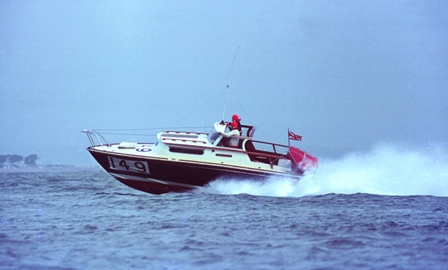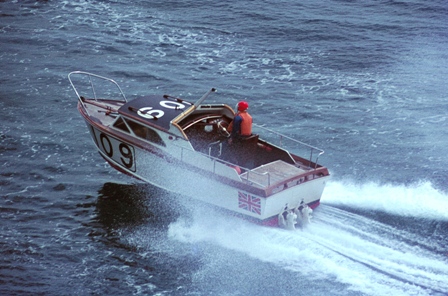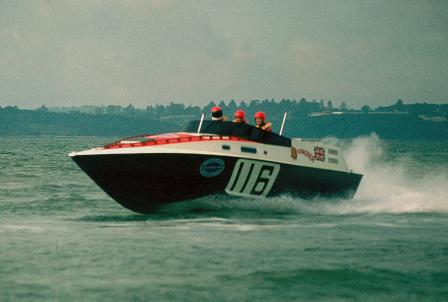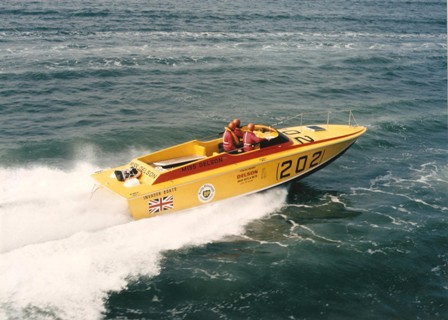The Privateers
Whilst recording the history of the early years of the sport, we have concentrated on the famous names and the winners. Therefore it would be totally unfair if we did not start recalling the people who not only raced their everyday cruisers but some who also designed and built their own entries. Whilst recording the history of the early years of the sport, we have concentrated on the famous names and the winners. Therefore it would be totally unfair if we did not start recalling the people who not only raced their everyday cruisers but some who also designed and built their own entries. Studying the entries for the 1961 Cowes Torquay race, firstly that of the initial entries which numbered some 60 craft and then the actual entry list, which was whittled down by the scrutineers to 27, you will find an array of craft and builders, some of whom were to go on to become household names. Shakespeare, Nelson, Fairey, Tod and Westcraft went on to bigger things and the drivers included Alan Veneables, Renato Levi, Denys Sessions and the Prout brothers. The craft varied in length from the 18 foot Westcraft “Ianthe” to the graceful Dorset Lake “Gay Gazell” at 39ft and Cedric Pochin’s “Anglesea” at 40ft. Of the 4 “own design” entries 3 started, Renato Levi’s A’Speranziella and Cmdr Peter Thorneycroft’s entries Vantage and Yeomana 3. The second race in ’62 saw the return of many of the ‘61 entrants plus new names many from the world of sailing and by ’63 they were all now regular entrants, Dennis Miller, Barry Heath and Farrant Gillham. The boatbuilder’s, Capt Morgan Giles, K. Bogeberg of Tod’s Weymouth, Denys Sessions of Port Hamble Marine and Alan Betteridge. One name that stood out in the third race was Ian Driver, with his own designed and built Black Marlin. Another was the Wagner/Hardingham boat Tangent and their subsequent racer Heatwave which in the pursuit of speed went down the 4 Jag’s route but never really succeeded in scoring a finish. In ’63 soon to be Tommy Sopwith’s navigator Charles de Selincourt raced the 25ft Bertram Paper Tiger, now owned by Ian Saunders and now fully restored. John Coombes of Jaguar fame raced the Freezer built Fairmile/Jaguar designed Cheetah powered by 2 Jaguar engines! Ex Air Force pilot Fred Carvill raced the Scandanavian built Bella 2, a 20ft Ancas cruiser and the eccentric Sir Robert Hobart had 2 entries Smoked Salmon a 33ft Hurricane class from R W Clark and the 25ft Christina Lobster Thermidor. The ‘63 entrants included several names soon to make their mark on the sport including one Charles Gardner driving the 25ft Bertram, Scorpion, Peter Blonde Max Aitkens co driver in Black Maria and Champion Steeplechaser Bill Shand-Kydd. By 1964, with the race well and truly established many of the earlier craft entered were now being bought by prospective entrants as the sport grew in stature and attracted more interest. Blue Moppie, raced by Sam Griffith and Dick Bertram in 62, was now owned by Keith Schellenberg of Olympic Bobsled fame in partnership with jockey Bill Shand Kydd, the races first winner Thunderbolt, was run by Ladies Downhill skier Hilary Laing. Charles Gardner’s Scorpion, was now raced by his wife, as he and his brother Jimmy traded up to a 31ft Bertram identical to Dick Bertram’s own boat. Dick Wilkins had sold Tramontana 2 and it was now raced by Tommy Sopwith, after his poor showing with the 31ft Bertram Thunderstreak the previous year. Don Shead had sold his little Levi designed Trident to Don Robertson and now raced the cut down Levi design Alto Volante with John Dalton and the Earl of Normanton. Peter and Jane Hicks who sank in 62 now had another Christina, Connie 3 but were soon to upgrade to a Fairey Huntsman called Seven Dials. For the first decade of the sport the entry list grew in size but was predominantly Cruiser based, with the “specials” making up the numbers.
The little Pacemakers from Port Hamble were easily transformed into racers one in particular “Jimani” looking very effective with her deflector shield instead of a glass windshield. Charles Currey had his own Huntsman built in a lighter than standard specification and this boat is still around today in the hands of Ben Curtis and now called Playtime. Talking of specials Sir William Piggott-Brown’s Swordsman Brown was as far removed from the production boat as it was ineffective despite having 2 powerful American V8 Interceptors as its motive power. Then there was Colin Mudie’s dramatic “NEWS OF THE WORLD” painted like an 18TH century English warship with mock cannon hatches. Another distinctive craft was the Fred Cross designed Jackie S with her hull design based on seaplane float principles with pronounced tumble home decks, she was very fast but the poor Doctor Savundra had no real luck with any of his entrants. His final boat the Teal designed Flying Jackie appeared at the London Boat Show then vanished after the collapse of FMA she was to be fitted with 2 Unicorn engines but even they swallowed money faster than his boats!.
Sadly it was still the man with the money who was winning the races. It was obvious in the late 60’s that the direction the sport was taking was into the big league and would leave behind many of the also rans, who in the early days stood a chance of winning silverware but now with the rapid development of hulls, machinery and the introduction of the OP1 and 2 classes so prevalent in the USA were left trailing in more respects than one. But still they came all determined to make their mark, witness the little Prawn Cocktail built by Woodnutts to a modified Shead design that originated with race winning TELSTAR, the owner even marinised the single American V8 himself. Alan Burnard put pen to paper a came up with Sea Fox built on a heavily modified Fairey hull in his garage, powered by twin Perkins diesels she proved very successful in the smaller class collecting an armful of silverware. Alan Beteridge started his racing days in the tiny Alphabet and outboard powered Uffa Fox design from Southern Speed Boats then moved up to DUM DUM a Senior Marine design with Bedford diesels before progressing to the very successful TRANSLUCENT built of grp but with no colouration hence the name!
Chris Tremlett supplied his hot moulded hulls to many would be entrants resulting in many varied and powered potent looking contenders, Mordicus had twin Aston Martins which were retained when John Robertshaw bought and renamed her Venus, Tremor had outboards and Crescendo’s 800 hp gave way to diesels when she became Firecracker and Anything Goes Thus had similar motive power. Although it made Tremlett’s name for solid build they never made the grade and the Aluminium Sheads were by now on a roll. Even in 1974 the one off’s were trying their hardest to make a mark witness the unique Miss Delson designed and built by veteran racer and lamination specialist Ken Raybould ideal for the changing waters of the Channel superbly built, finished races but were stumped for lack of development money, if the big engines planned were fitted and the weather was on her side who knows what may have resulted. Even in the late 70’s Lady Arran was not adverse to trying forward thinking from the young designers of the day especially Lorne Campbell’s multi pointers but their days were numbered even the use of ex winners revamped and re engined did not pay off except perhaps in one case when Charles Gill beat the best that the USA had with I LIKE IT TOO no 69 at a speed of appropriately 69 mph, was this the privateers swan song?.
|





